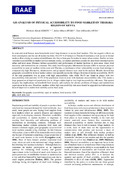GIS Analysis of Physical Accessibility to Food Markets in Tharaka Region of Kenya

Date
2020Author
KIBETU, Dickson Kinoti
HUHO, Julius Mburu
OUNA, Tom Odhiambo
Metadata
Show full item recordAbstract
In semi-arid rural Kenya, most households travel long distances to access food markets. This has negative effects on
food consumption and the use of market facilities. Over70 % of farmers in Tharaka Constituency lack access to formal
markets often relying on contracted middlemen who buy at farm gate for traders in major urban centres. Studies on intravariation in accessibility to market services remains scanty, yet market purchases account for most food consumed across
urban and rural areas. Distance defines accessibility and performance of market facilities in most areas where food
insecurity and malnutrition are common. This study used Geographic Information Systems (GIS) to measure physical
accessibility to open air markets within semi-arid Tharaka, a constituency where vulnerability to acute food shortage is
comparatively high. Normative, administrative and geospatial datasets were used in the analysis. Results showed that
geographic accessibility to local market centres vary spatially across the villages. In terms of market accessibility, 40.4%
of the total population live in areas with high inaccessibility risks while 36.1% are found in places with low
inaccessibility risks and only 23.5% of the population exists in areas with moderate inaccessibility risks. This means a
large proportion of deprived population live in villages within high to very high inaccessibility risk areas. This spatial
inequity has implications on household food security and explains the chronic problems of hunger and malnutrition
experienced in the area. Therefore, markets within high inaccessibility risk areas should be upgraded and infrastructure
thereof improved to enable food mobility across these areas.